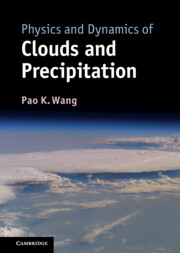Book contents
- Frontmatter
- Contents
- Preface
- 1 Observation of clouds
- 2 The shape and size of cloud and precipitation particles
- 3 Molecular structures of water substance
- 4 Bulk thermodynamic equilibrium among water vapor, liquid water, and ice
- 5 Surface thermodynamics of water substance
- 6 Aerosol in the atmosphere
- 7 Nucleation
- 8 Hydrodynamics of cloud and precipitation particles
- 9 Diffusion growth and evaporation of cloud and precipitation particles
- 10 Collision, coalescence, breakup, and melting
- 11 Cloud drop population dynamics in the warm rain process
- 12 Fundamental cloud dynamics
- 13 Numerical cloud models
- 14 Cloud electricity
- 15 Clouds–environment interaction
- References
- Index
- Plate section
7 - Nucleation
Published online by Cambridge University Press: 05 March 2013
- Frontmatter
- Contents
- Preface
- 1 Observation of clouds
- 2 The shape and size of cloud and precipitation particles
- 3 Molecular structures of water substance
- 4 Bulk thermodynamic equilibrium among water vapor, liquid water, and ice
- 5 Surface thermodynamics of water substance
- 6 Aerosol in the atmosphere
- 7 Nucleation
- 8 Hydrodynamics of cloud and precipitation particles
- 9 Diffusion growth and evaporation of cloud and precipitation particles
- 10 Collision, coalescence, breakup, and melting
- 11 Cloud drop population dynamics in the warm rain process
- 12 Fundamental cloud dynamics
- 13 Numerical cloud models
- 14 Cloud electricity
- 15 Clouds–environment interaction
- References
- Index
- Plate section
Summary
Conventionally, the condensation of water in the atmosphere was thought to occur spontaneously once water vapor exceeded saturation (either by cooling or by addition of water vapor). Yet experimentally it has been shown that, in a very clean environment, the vapor pressure can significantly exceed the saturation value without condensation. We have mentioned this supersaturation phenomenon before. Similarly, the conventional wisdom of freezing is that liquid water will freeze into ice once the temperature drops to below 0°C, yet experiments and observations show that supercooling occurs very frequently, and that certainly is the case for atmospheric clouds.
The fundamental process of phase change is nucleation. The condensation of liquid water from expansive and highly random water vapor does not occur in a large quantity in its initial stage but first appears as small clusters of molecules that have properties close to bulk liquid. Similarly, the freezing of liquid water to form ice also occurs as small clusters of molecules that have quasi-ice properties. Once these clusters stabilize and continue to grow, we will then see bulk water and ice phases forming. The formation of these quasi-condensed phase clusters is the nucleation process and is the main subject of this chapter.
- Type
- Chapter
- Information
- Physics and Dynamics of Clouds and Precipitation , pp. 156 - 181Publisher: Cambridge University PressPrint publication year: 2013



